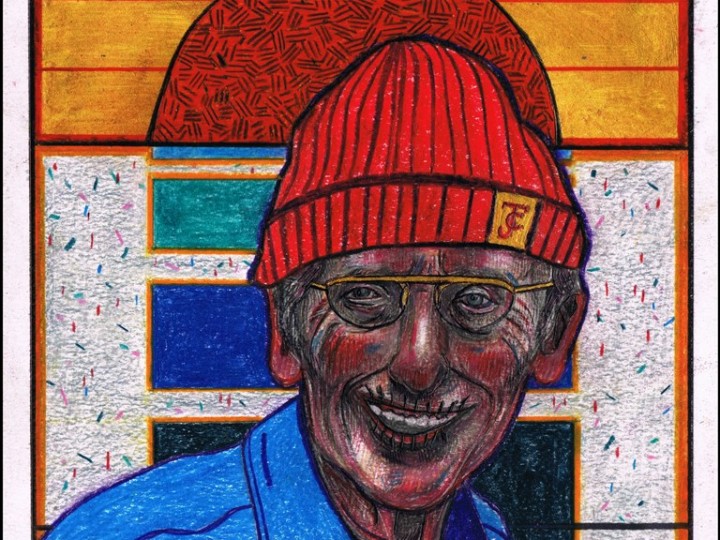Blank Malaysia’s Well-Informed, Vivid Portraiture
 Thirsty for JUICE content? Quench your cravings on our Instagram, TikTok and WhatsApp
Thirsty for JUICE content? Quench your cravings on our Instagram, TikTok and WhatsApp

If you’re lucky, you may have spotted the work of A.J. Roberts – or Blank Malaysia – at various places in the city, be it unassumingly placed on lampposts, plastered on the walls of cafés, or neatly arranged as exhibited at some of the many small exhibitions he’s participated in. Examining his portraits, it is apparent that A.J. is a well-read individual. He consumes worldly news and literature, and as a response to the information he’s retained, he creates these pieces of art that he hopes would compel people to experience them in their own respective ways. JUICE spoke to the artist via email to get to know the motivations behind his pieces, his process of creation, and more.
How did you come to develop your skills and techniques? Were you self-taught?
Yes. Being self-taught, I had developed a cycle of steps that guide me through the creative process: Learn a technique, produce pieces in said technique, merge new skill with prior learnt techniques. Repeat Step 1.
What was your intention when you started as an artist under the name Blank Malaysia?
I made art in reaction to the imbalance of appreciation between the contemporary art scene and the masses. Duchamp changed the world when he made a urinal an art piece. Art shed its classical chains and aimed to project raw emotions to the viewers, championing concepts and ideas. However, as time went by, many of the masses continue to grow more jaded with newer and more outlandish contemporary pieces. Contemporary Art had made a wall around itself, laughing at those who “did not get it.” Most can’t appreciate the formal qualities of an abstract painting because they do not have context to understand the piece or artist. I want art to be able to provide both beauty and ideas that could be applied within various formats for everyone to enjoy, from architecture to music.
You’re clearly well-informed about the news of the world and some of your art are inspired by newsworthy events. How much reading do you usually do when you are illustrating a piece based on some of these events?
My art pieces were created from the reaction of the things that I was currently experiencing. I could be reading, listening to the news or a podcast, watching a documentary, etc. The information that I get inspires images that I would try to use in my work. For example, my piece titled ‘David’ was a reaction to a book called Jerusalem by Simon Sebag Monteriore. David symbolises a young nation while the background consists of geometric shapes that coincides with the historical timeline of the various conquerors of the holy land.

Do you think that your work, in a way, serves as a starting point to motivate people to learn more about a certain subject matter?
Yes, but it depends on the person appreciating it. I create my pieces to be experienced differently by different individuals. You could observe the piece as a whole. The colours, the portrait, pencil strokes, etc., would be used to evoke an immediate reaction of like or disgust. Or, you could take a closer look at the portrait, the arrangement of lines or colours while thinking of the artist’s intentions and context of the piece. Or, you use your own values in aesthetics and use it to understand the piece from your perspective.
Why did you make the decision to place your art around KL and make them free?
I believe art serves to elevate and evoke emotions in one’s life. Art should be experienced by everyone, from the streets to galleries. We can already observe this as our technology continue to incorporate design and art at the beginning of the 21st century.
What sort of qualities do you look for when you are drawing a particular personality? Because there have been quite a varied few from Putin, to the deceased CEO of Nintendo, to putting a face on disenfranchised people.
Mostly I gravitate towards sombre or highly emotional expressions taken anywhere from newspaper cuttings to photos. Usually, I just use models of close friends or old portraits from early 20th century to represent the issue that I wish to speak of.
What do you hope for people to take away from your art?
I want them to grow more aware of the role that aesthetics and ideas play in defining what reality is. Everything we see is designed, from roads to paper cups. The only difference between a frenetic overcrowded city and a walkable, liveable one is the concept of aesthetics behind it.
What are your future plans for Blank Malaysia?
I am interested in collaborating with 21 places around KL (cafés, galleries, restaurants) for a short art project called 21 x 21. I had created 21 framed pieces to be placed within 21 establishments around the city. All pieces will be sold for RM441. To those who are interested to be involved in the project could message me personally at [email protected].
View a selection of his work below:
www.facebook.com/BlankMalaysia
www.instagram.com/blankmalaysia


 Get Audio+
Get Audio+ Hot FM
Hot FM Kool 101
Kool 101 Eight FM
Eight FM Fly FM
Fly FM Molek FM
Molek FM




